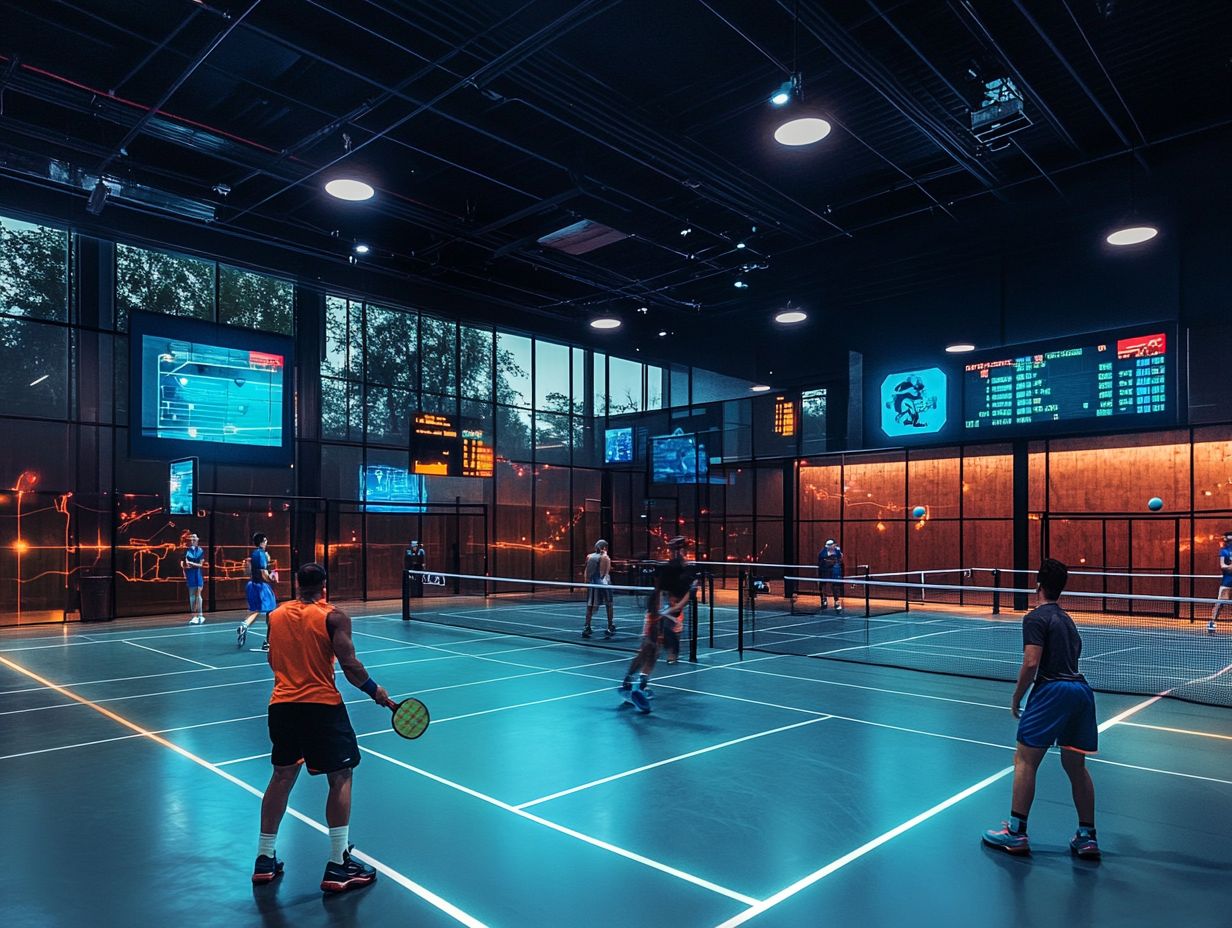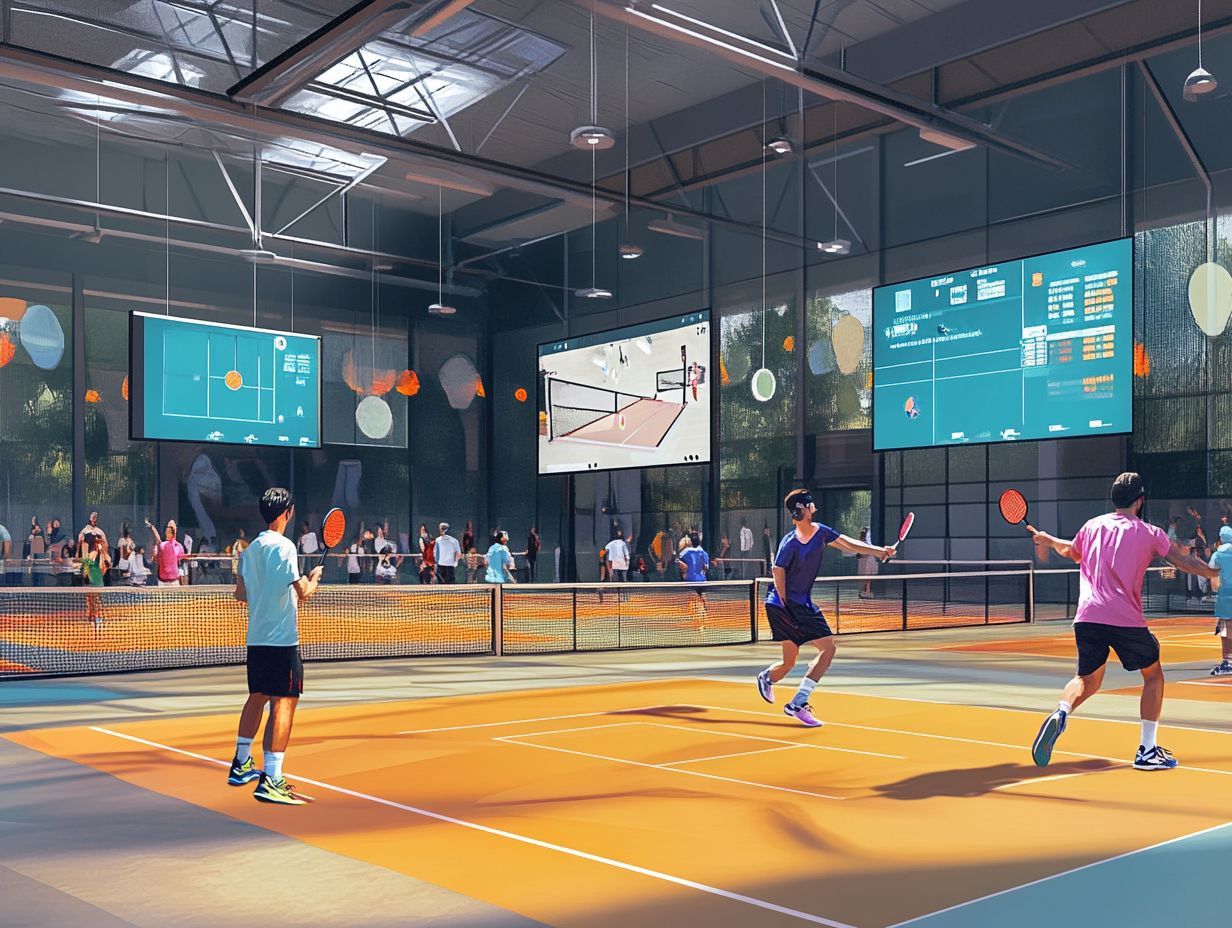Pickleball has quickly transformed from a casual backyard pastime into a dynamic sport that has captured the hearts of millions. This article delves into the rich history of pickleball, its current surge in popularity, and the technological advancements that are reshaping the game.
It discusses participation statistics, innovative equipment, and their impact on performance, while also highlighting trends such as the sport’s inclusion in schools and professional leagues.
By examining the challenges and opportunities that lie ahead, this article invites you to discover what the future holds for this exciting sport.
History and Evolution of the Sport

Pickleball History – Pickleball was invented in the mid-1960s as a family-friendly sport that combines elements of tennis, badminton, and ping pong. Since its inception, pickleball has evolved significantly through various innovations and adaptations.
The game has undergone transformations in equipment design and court surfaces to cater to players of all ages, contributing to its popularity and fostering community growth and youth engagement. Initially developed as a pastime for children during a summer vacation, the sport was quickly embraced by adults.
By 1976, the first official pickleball tournament was held, and the establishment of standardized rules over the years promoted fair play and competition, enhancing its appeal to a wider audience. The introduction of newer paddles and balls tailored to different skill levels has further expanded the sport’s reach.
As schools and local communities embraced pickleball, it became evident that its inclusive nature provides a welcoming environment. This encourages players from diverse backgrounds, fosters friendships, and promotes physical activity among youth and families alike.
Current State of Pickleball
Pickleball is currently experiencing unprecedented growth, with participation rates skyrocketing across various demographic groups as more players recognize the sport’s numerous fitness benefits and its accessibility compared to traditional racquet sports.
This surge in popularity reflects a growing interest in recreational activities, community events, and grassroots initiatives that promote the sport in local parks and clubs.
Popularity and Participation Statistics
The following statistics illustrate the rising popularity of pickleball, which has seen a notable increase in participation across various age demographics, particularly among youth and older adults who appreciate the sport’s accessibility and fitness benefits.
Over the past year, surveys indicate a growing number of community-led initiatives introducing pickleball as a healthy and enjoyable activity. Participation rates are highest among individuals aged 50 and above, reflecting a trend as people seek engaging ways to maintain their physical health and social well-being.
The sport is also gaining popularity among younger individuals, particularly those aged 18 to 34, due to its fun, fast-paced nature and community-oriented atmosphere. Various organizations are intensifying their efforts to offer pickleball programs in community centers and local schools, demonstrating a strong commitment to creating an inclusive environment for all skill levels.
These collective efforts not only encourage more individuals to participate but also emphasize significant health benefits, such as improved agility, cardiovascular fitness, and mental well-being, further enhancing the sport’s popularity.
Technological Advancements in Pickleball

Technological advancements are transforming pickleball by enhancing both player performance and the overall experience on the court through innovations in equipment design and sports technology.
Features such as smart paddles equipped with performance analytics and wearable technology that tracks health metrics are revolutionizing how players engage with the sport and approach their training.
Innovative Equipment and Gear
Recent advancements in equipment and gear designed to enhance performance in pickleball include technological improvements related to paddles. These paddles now feature integrated sensors that create smart paddles, providing athletes with real-time analytics on their performance and shot accuracy.
Along with specialized training equipment, such as ball machines and footwork ladders, these innovations enable players of all skill levels to practice and perfect their skills and strategies. This evolution in pickleball equipment not only enhances gameplay but also transforms the ways in which players and fans interact with and engage in the sport.
Impact on Gameplay and Performance
Technological innovations significantly impact gameplay and performance in pickleball. Performance analytics and fitness apps provide players with valuable insights into their strengths and weaknesses, enabling them to make targeted improvements to their game strategies.
These tools enhance performance and facilitate the development of effective coaching techniques that adapt to each player’s unique play style. By utilizing advanced data collection methods, players can analyze metrics such as shot accuracy, court coverage, and reaction times.
This analytical approach allows players to identify specific areas that need improvement, paving the way for focused training regimens. Additionally, fitness apps track physical conditioning and recovery, ensuring that players can maintain peak athletic performance.
Coaches equipped with these technological tools can create individualized training programs, enabling their athletes to practice their skills more efficiently and effectively. Overall, technology is rapidly transforming the landscape of pickleball, increasing player engagement and pushing them to achieve new heights of competitive performance.
Trends Shaping the Future of Pickleball

Several trends are poised to influence the future of pickleball as the sport continues to grow. These include the introduction of smart paddles and online coaching platforms that enhance training experiences for players.
Additionally, community outreach and youth involvement initiatives are crucial for fostering a strong pickleball culture and ensuring the sport’s ongoing development.
Inclusion in Schools and Professional Leagues
The inclusion of pickleball in schools and professional leagues signifies a significant shift in the perception of sports, fostering youth engagement and community growth. As more educational institutions incorporate pickleball into their physical education curriculum, they not only promote physical fitness but also cultivate an appreciation for the sport among young people.
This trend encourages students to develop essential social skills, such as teamwork and communication, as they actively participate in a fun and inclusive activity. Schools that implement pickleball programs have reported improved student attendance and a decrease in unhealthy habits, as children are naturally drawn to its energetic and engaging nature.
Community initiatives aimed at introducing this sport encourage family participation, maximizing intergenerational interactions. Local leagues and school tournaments promote healthy competition, allowing players to experience the benefits of both physical and mental wellness, ultimately leading to stronger community bonds.
International Growth and Expansion
The international growth and expansion of pickleball are evident as the sport gains a global presence through grassroots movements and local events that highlight its accessibility and enjoyment.
Countries worldwide are actively developing and promoting pickleball through tournaments, local clubs, and supportive environments for players of all abilities. In recent years, various organizations have committed to fostering the sport’s proliferation by offering coaching resources and training, as well as launching social media campaigns to raise awareness.
These initiatives aim to connect players of all levels and create opportunities for events that emphasize collaboration and friendly competition. Local clubs play a vital role in this growth by providing regular play and tournament opportunities for players from diverse backgrounds.
These efforts not only help to increase awareness of pickleball but also foster a community dedicated to promoting both the enjoyment and improvement of the sport.
Challenges and Opportunities for Pickleball

The growth of pickleball faces challenges, such as barriers to entry and a lack of player support; however, these obstacles are balanced by significant opportunities for innovation and enhancing the sport’s appeal.
Issues related to injury prevention and thorough market research present challenges that can ultimately create new opportunities for engagement and increased participation in the sport’s future.
Overcoming Barriers to Entry
Overcoming barriers to entry is essential for the continued growth of pickleball, particularly regarding accessibility for players of all backgrounds and ability levels, including adaptive pickleball for individuals with physical challenges and disabilities. By creating an inclusive environment, we can foster community growth and encourage participation from a broader audience.
To achieve this, it is crucial to address common obstacles such as access to equipment, available facilities, and mobility restrictions. Possible initiatives include:
- Providing loaner paddles and balls at local courts,
- Offering community workshops to teach the game, and
- Collaborating with adaptive sports organizations to ensure that everyone has an opportunity to play.
Communities can also play a significant role by establishing leagues that promote inclusiveness and hosting events specifically designed for players of varying abilities. These initiatives can help close gaps and build connections within neighborhoods, ensuring that the joy of pickleball is accessible to all.
Potential for Further Development and Innovation
The potential for further development and innovation in pickleball is vast, encompassing advancements in coaching platforms, sustainability efforts, and new sponsorship opportunities that can enhance the sport’s visibility and reach.
By prioritizing sustainable practices and leveraging partnerships, the sport can continue to grow and attract a broader audience. Enhancements in coaching platforms could revolutionize how players at all levels learn and improve their skills, possibly incorporating virtual training sessions or mobile apps that offer customized feedback.
Simultaneously, sustainability initiatives can involve the use of eco-friendly materials in equipment and promote responsible event management, ensuring that the sport respects its environment.
Additionally, forming partnerships with local businesses and larger brands could lead to unique sponsorships, enabling collaborative marketing campaigns that not only generate funding but also foster a sense of community around the sport.
Such a unified approach could elevate pickleball, making it a staple in community recreation and appealing to environmentally conscious consumers.

Pickleball’s more than a game to me—it’s a passion. I write, sharing its highs and lows, the thrills and the lessons. Some tales might draw you to the court, while others give a hint of the game’s magic. So, curious about my journey? Ready to dive deep into the world of pickleball with me? Let’s go.
